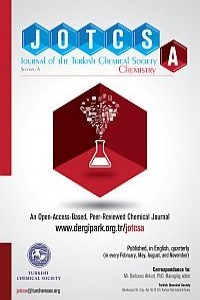Removal Of Sumifix Yellow EXF Reactive Azo Dye By Electro-Fenton Method
Removal Of Sumifix Yellow EXF Reactive Azo Dye By Electro-Fenton Method
___
- 1. Babuponnusami A, Muthukumar K. A review on Fenton and improvements to the Fenton process for wastewater treatment. Vol. 2, Journal of Environmental Chemical Engineering. Elsevier Ltd; 2014. p. 557–72. Available from:
- 2. Carmen Z, Daniela S. Textile Organic Dyes-Characteristics, Polluting Effects and Separation/Elimination Procedures from Industrial Effluents-A Critical Overview [Internet]. Available from:
- 3. Zhang S, Tappe H, Helmling W, Mischke P, Rebsamen K, Reiher U, et al. Reactive Dyes. In: Ullmann’s Encyclopedia of Industrial Chemistry [Internet]. Weinheim, Germany: Wiley-VCH Verlag GmbH & Co. KGaA; p. 1–20. Available from:
- 4. Şahinkaya S. COD and color removal from synthetic textile wastewater by ultrasound assisted electro-Fenton oxidation process. Journal of Industrial and Engineering Chemistry. 2013 Mar 25;19(2):601–5. Available from:
- 5. Hunger K, Mischke P, Rieper W. Azo Dyes, 1. General. In: Ullmann’s Encyclopedia of Industrial Chemistry. Wiley-VCH Verlag GmbH & Co. KGaA; 2011. Available from:
- 6. Jager D, Kupka D, Vaclavikova M, Ivanicova L, Gallios G. Degradation of Reactive Black 5 by electrochemical oxidation. Chemosphere. 2018;190:405–16. Available from:
- 7. Liu X, Yin H, Lin A, Guo Z. Effective removal of phenol by using activated carbon supported iron prepared under microwave irradiation as a reusable heterogeneous Fenton-like catalyst. J Environ Chem Eng. 2017 Feb 1;5(1):870–6. Available from:
- 8. Wang X, Jiang J, Gao W. Reviewing textile wastewater produced by industries: characteristics, environmental impacts, and treatment strategies. Vol. 85, Water Science and Technology. IWA Publishing; 2022. p. 2076–96. Available from:
- 9. Do TM, Byun JY, Kim SH. An electro-Fenton system using magnetite coated metallic foams as cathode for dye degradation. Catal Today. 2017 Oct 15;295:48–55. Available from:
- 10. Kremer ML. Mechanism of the Fenton reaction. Evidence for a new intermediate. Physical Chemistry Chemical Physics. 1999 Aug 1;1(15):3595–605. Available from:
- 11. Zhou M, Yu Q, Lei L, Barton G. Electro-Fenton method for the removal of methyl red in an efficient electrochemical system. Sep Purif Technol. 2007 Oct 15;57(2):380–7. Available from:
- 12. Ganiyu SO, Zhou M, Martínez-Huitle CA. Heterogeneous electro-Fenton and photoelectro-Fenton processes: A critical review of fundamental principles and application for water/wastewater treatment. Vol. 235, Applied Catalysis B: Environmental. Elsevier B.V.; 2018. p. 103–29. Available from:
- 13. Zhang H, Fei C, Zhang D, Tang F. Degradation of 4-nitrophenol in aqueous medium by electro-Fenton method Degradation of 4-nitrophenol in aqueous medium by electro-Fenton method. J Hazard Mater. 2007 Jun 25;145(1–2):227–32. Available from:
- 14. Moreira FC, Boaventura RAR, Brillas E, Vilar VJP. Electrochemical advanced oxidation processes: A review on their application to synthetic and real wastewaters. Vol. 202, Applied Catalysis B: Environmental. Elsevier B.V.; 2017. p. 217–61. Available from:
- 15. Nidheesh P v., Gandhimathi R. Trends in electro-Fenton process for water and wastewater treatment: An overview. Vol. 299, Desalination. 2012. p. 1–15. Available from:
- 16. Smith, R. M., Martell, A. E. Critical Stability Constants, 4, Inorganic Complexes; 1976. 270 p. ISBN: 0608093653, 9780608093659. Available from:
- 17. Neta P, Huie RE, Ross AB. Rate·Constants for Reactions of Inorganic Radicals in Aqueous Solution [Internet]. Available from:
- 18. de Laat J, Truong Le G, Legube B. A comparative study of the effects of chloride, sulfate and nitrate ions on the rates of decomposition of H2O2 and organic compounds by Fe(II)/H2O2 and Fe(III)/H2O 2. Chemosphere. 2004;55(5):715–23. Available from:
- 19. Gökkuş Ö, Yıldız YŞ. Application of electro-Fenton process for medical waste sterilization plant wastewater. Desalination Water Treat. 2016 Nov 7;57(52):24934–45. Available from:
- 20. Muruganandham M, Swaminathan M. Decolourisation of Reactive Orange 4 by Fenton and photo-Fenton oxidation technology. Dyes and Pigments. 2004 Dec;63(3):315–21. Available from:
- 21. Ghoneim MM, El-Desoky HS, Zidan NM. Electro-Fenton oxidation of Sunset Yellow FCF azo-dye in aqueous solutions. Desalination. 2011 Jul 1;274(1–3):22–30. Available from:
- 22. Lei H, Li H, Li Z, Li Z, Chen K, Zhang X, et al. Electro-Fenton degradation of cationic red X-GRL using an activated carbon fiber cathode. Process Safety and Environmental Protection. 2010 Nov;88(6):431–8. Available from:
- 23. Wang CT, Hu JL, Chou WL, Kuo YM. Removal of color from real dyeing wastewater by Electro-Fenton technology using a three-dimensional graphite cathode. J Hazard Mater. 2008 Apr 1;152(2):601–6. Available from:
- 24. Ai Z, Mei T, Liu J, Li J, Jia F, Zhang L, et al. Fe@Fe2O3 core-shell nanowires as an iron reagent. 3. Their combination with CNTs as an effective oxygen-fed gas diffusion electrode in a neutral electro-fenton system. Journal of Physical Chemistry C. 2007 Oct 11;111(40):14799–803. Available from:
- 25. Wang CT, Chou WL, Chung MH, Kuo YM. COD removal from real dyeing wastewater by electro-Fenton technology using an activated carbon fiber cathode. Desalination. 2010 Apr;253(1–3):129–34. Available from:
- 26. Shemer H, Linden KG. Degradation and by-product formation of diazinon in water during UV and UV/H2O2 treatment. J Hazard Mater. 2006 Aug 25;136(3):553–9. Available from:
- 27. Wang Q, Lemley AT. Kinetic model and optimization of 2,4-D degradation by Anodic Fenton treatment. Environ Sci Technol. 2001 Nov 15;35(22):4509–14. Available from:
- 28. Ting WP, Lu MC, Huang YH. Kinetics of 2,6-dimethylaniline degradation by electro-Fenton process. J Hazard Mater. 2009 Jan 30;161(2–3):1484–90. Available from:
- 29. Akyol A, Can OT, Demirbas E, Kobya M. A comparative study of electrocoagulation and electro-Fenton for treatment of wastewater from liquid organic fertilizer plant. Sep Purif Technol. 2013 July 10;112: 11–9. Available from:
- Başlangıç: 2014
- Yayıncı: Türkiye Kimya Derneği
3- and 4-Arm Star Polymers (PEG3 and PEG4) via Metal-Free Azide-Alkyne Click Reaction
Fekadu Tumoro ERABE, Dagne Adisu KURE, Salah SHERİF
Differences in Heavy Metals Adsorption on Natural, Modified, and Synthetic Zeolites-A Review
Sebghatullah MUDABER, Jenaidullah BATUR
Bedriye Seda KURŞUN AKTAR, Abdulraheem Mustafa ALKARABASH, Ayşe ŞAHİN YAĞLIOĞLU, Emine Elçin ORUÇ-EMRE
Ekhlas ABD ALKAREEM, Nuha FARHAN ABD AL-KARİM, Israa I MAHMOUD
